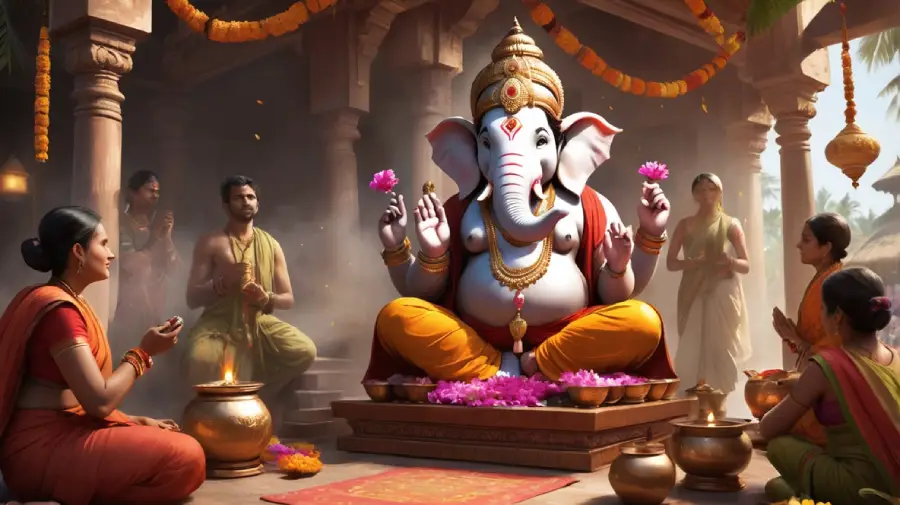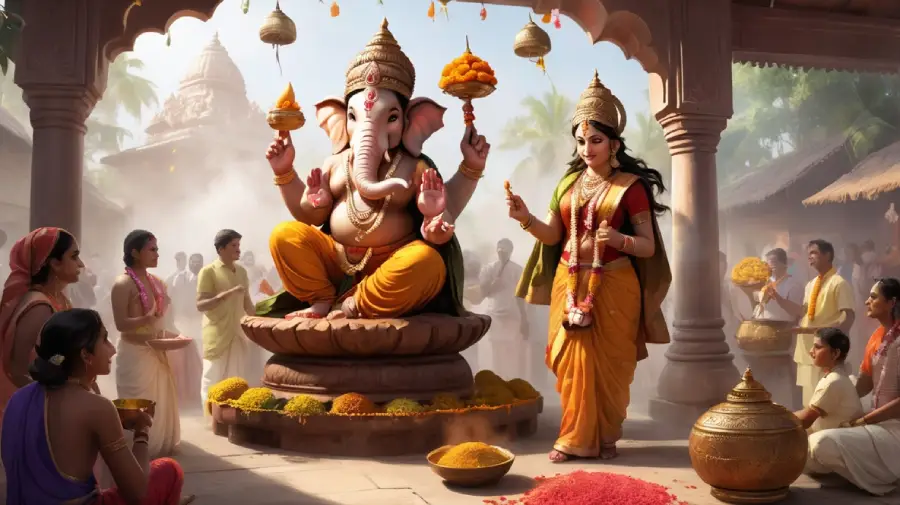Ganesh Chaturthi, Lord Ganesha, Ganesh Visarjan
Ganesh Chaturthi: A Celebration of Lord Ganesha’s Birth and Blessings
Ganesh Chaturthi, also known as Vinayaka Chaturthi, is one of the most celebrated festivals in India. It marks the birth of Lord Ganesha, the beloved elephant-headed deity worshipped as the remover of obstacles and the god of new beginnings. This festival is celebrated with immense devotion and joy, especially in the Indian state of Maharashtra, and spans over ten days, starting from Shukla Chaturthi (the fourth day of the waxing moon) to Anant Chaturdashi (the fourteenth day).
This article provides an in-depth look at the significance, customs, and unique traditions associated with Ganesh Chaturthi, including the grand celebrations, rituals, and the deep-rooted beliefs surrounding Lord Ganesha.

- Wednesday, 27 August 2025
- Monday, 14 September 2026
- Saturday, 04 September 2027
- Thursday, 24 August 2028
What is Ganesh Chaturthi?
Ganesh Chaturthi is a Hindu festival that celebrates the birth of Lord Ganesha, the son of Lord Shiva and Goddess Parvati. It is observed annually, with the date of the festival depending on the lunar calendar. In 2024, Ganesh Chaturthi will be celebrated on Saturday, September 7, and in 2025, it will fall on Wednesday, August 27.
Lord Ganesha is revered as the god of wisdom, knowledge, prosperity, and remover of obstacles. His image is easily recognizable by his elephant head and large, pot-bellied form, often depicted holding various objects that symbolize his divine attributes.

Significance of Lord Ganesha
Lord Ganesha holds a special place in Hinduism and is worshipped by millions across the globe. Known as the god of new beginnings, Ganesha is often invoked before any major endeavor, whether it’s a wedding, business venture, or academic pursuit. This is because Ganesha is believed to remove obstacles and ensure success.
Moreover, Ganesha is associated with intellect, wisdom, and the arts. He is considered the patron deity of writers, scholars, and students. His devotees often seek his blessings for knowledge, good fortune, and prosperity.
History and Mythology of Ganesh Chaturthi
The origins of Ganesh Chaturthi are rooted in Hindu mythology. According to one popular story, Goddess Parvati created Lord Ganesha from the dirt of her body while she was bathing. She tasked him with guarding her entrance. However, when Lord Shiva returned home, he was stopped by Ganesha, who didn’t recognize him and refused to let him enter. This led to a heated confrontation, and in his anger, Lord Shiva severed Ganesha’s head.
When Parvati discovered this, she was heartbroken and demanded that her son be brought back to life. In response, Lord Shiva ordered his followers to bring the head of a child whose mother had her back turned. They returned with the head of an elephant, which Lord Shiva attached to Ganesha’s body, bringing him back to life. Since then, Ganesha has been worshipped as the remover of obstacles and a symbol of wisdom and prosperity.
Ganesh Chaturthi Rituals and Celebrations
Preparing for Ganesh Chaturthi
Before the festival begins, artisans begin crafting idols of Lord Ganesha, using clay and other materials. These idols come in various sizes, ranging from small ones for personal worship to massive statues that can be over 25 feet tall, often placed in public spaces.
On the first day of Ganesh Chaturthi, families bring home their Ganesha idols, often covering the idol’s face with a cloth. This is done in accordance with tradition, as the idol is believed to be lifeless until it is consecrated through prayers.
Pranapratishtha Puja: Bringing the Idol to Life
The festival officially begins with the Pranapratishtha Puja, a ritual where a priest brings the idol to life through specific prayers and mantras. During this ritual, offerings of flowers, sweets, coconuts, jaggery, and other items are made to the deity. This puja is considered an essential step in welcoming Lord Ganesha into the home.
Shhodashopachara Puja: The Sixteen Prayers
The next important ritual is the Shhodashopachara Puja, which involves sixteen different forms of worship, including the offering of incense, light, fruits, and the chanting of mantras. Each of these steps is intended to honor Lord Ganesha and ensure his blessings on the devotees.
Visarjan: The Immersion Ritual
On the final day of Ganesh Chaturthi, Ganesh Visarjan (the immersion of the idol) takes place. This is the culmination of the ten-day festivities. Devotees gather in large processions, singing devotional songs and dancing, as they carry the idol to a nearby river, lake, or sea to immerse it.
The immersion symbolizes the departure of Lord Ganesha to his heavenly abode, Mount Kailash, where he is said to reunite with his parents, Lord Shiva and Goddess Parvati. It is believed that during this journey, Lord Ganesha takes away all the problems and obstacles of his devotees.

Ganesh Chaturthi in Different Regions
While Ganesh Chaturthi is celebrated nationwide, it holds particular significance in the state of Maharashtra, where the festival is marked by large public gatherings and colorful processions. Other regions such as Goa, Tamil Nadu, Karnataka, Kerala, and Andhra Pradesh also observe the festival with great enthusiasm. Each state and region has its unique traditions, but the core customs of worshipping Ganesha, offering prayers, and immersing the idol in water remain consistent across the country.
Unique Traditions and Offerings During Ganesh Chaturthi
- Modak: Lord Ganesha’s favorite sweet is Modak, a dumpling made from rice flour and filled with a sweet mixture of coconut and jaggery. It is believed that offering Modak to Ganesha pleases him and brings blessings to the devotee.
- Vahana (Mount): Unlike most Hindu deities, Lord Ganesha’s vahana, or vehicle, is a mouse. This is symbolic of Ganesha’s ability to overcome obstacles of all sizes, from the smallest to the largest.
- Ganesh Mantras: Devotees chant various mantras, such as the Ganapati Atharvasirsha, to invoke Lord Ganesha’s blessings. These mantras are believed to bring prosperity and eliminate negative energies from the surroundings.

Why Do People Celebrate Ganesh Chaturthi?
Ganesh Chaturthi is celebrated to honor Lord Ganesha, the deity who brings good fortune and success. People invoke his blessings before embarking on new ventures, whether it’s starting a new business, building a home, or beginning a new academic journey. It is also a time for families to come together, share meals, and participate in community festivities.
The Environmental Concerns: Eco-Friendly Ganesh Chaturthi
In recent years, there has been growing concern about the environmental impact of Ganesh Chaturthi, particularly the use of non-biodegradable materials for making idols. The immersion of these idols, often made from plaster of Paris and painted with toxic chemicals, contributes to water pollution. As a result, many people and communities have started adopting eco-friendly practices, such as using clay idols and conducting symbolic immersion in buckets of water.
The Spirit of Ganesh Chaturthi
Ganesh Chaturthi is more than just a festival; it is a time of joy, togetherness, and spiritual awakening. Whether celebrated in grand public celebrations or in the privacy of one’s home, the essence of the festival lies in the devotion and reverence with which Lord Ganesha is worshipped. His blessings are sought for new beginnings, wisdom, prosperity, and the removal of obstacles, making Ganesh Chaturthi a festival that holds immense cultural and spiritual significance for millions of people worldwide.
FAQs
- When is Ganesh Chaturthi in 2024? Ganesh Chaturthi will be celebrated on Saturday, September 7, 2024.
- What is the significance of Ganesh Visarjan? Ganesh Visarjan marks the immersion of Lord Ganesha’s idol in water, symbolizing his return to Mount Kailash and the removal of obstacles from the devotee’s life.
- What is Lord Ganesha’s favorite sweet? Modak is Lord Ganesha’s favorite sweet, made of coconut and jaggery wrapped in rice flour.
- Why do people worship Lord Ganesha before starting anything? Lord Ganesha is known as the remover of obstacles, so people worship him before beginning new ventures to ensure success and good fortune.
- What is the meaning of Pranapratishtha Puja? Pranapratishtha Puja is a ritual where the idol of Lord Ganesha is consecrated and brought to life through prayers, making it an important part of Ganesh Chaturthi celebrations.


